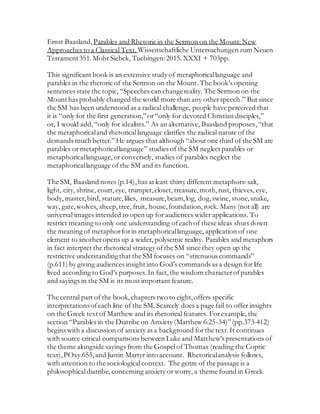Report
Share

Recommended
Recommended
Paper with References for H and his World - Dr. John Carey, MRIA, Dept. of Early & Medieval Irish, UCC. For additional information including audio recordings to accompany this presentation please click here - http://www.ria.ie/library/exhibitions/lebor-na-huidre-conference.aspx.
Disclaimer:
The Royal Irish Academy has prepared the content of this website responsibly and carefully, but disclaims all warranties, express or implied, as to the accuracy of the information contained in any of the materials. The views expressed are the authors’ own and not those of the Royal Irish Academy.
Paper with References for H and his World - Dr. John Carey, MRIA, Dept. of Ea...

Paper with References for H and his World - Dr. John Carey, MRIA, Dept. of Ea...The Royal Irish Academy
More Related Content
Similar to ATR Review Ernst Baasland July 2016
Paper with References for H and his World - Dr. John Carey, MRIA, Dept. of Early & Medieval Irish, UCC. For additional information including audio recordings to accompany this presentation please click here - http://www.ria.ie/library/exhibitions/lebor-na-huidre-conference.aspx.
Disclaimer:
The Royal Irish Academy has prepared the content of this website responsibly and carefully, but disclaims all warranties, express or implied, as to the accuracy of the information contained in any of the materials. The views expressed are the authors’ own and not those of the Royal Irish Academy.
Paper with References for H and his World - Dr. John Carey, MRIA, Dept. of Ea...

Paper with References for H and his World - Dr. John Carey, MRIA, Dept. of Ea...The Royal Irish Academy
Similar to ATR Review Ernst Baasland July 2016 (20)
Philosophical Genres and Literary Forms A Mildly Polemical.docx

Philosophical Genres and Literary Forms A Mildly Polemical.docx
THE TRINITARIAN PARADIGM: The Double Helix, The Kundalini Serpent, The Breath...

THE TRINITARIAN PARADIGM: The Double Helix, The Kundalini Serpent, The Breath...
THE PAULINE CONCEPT OF WOMEN ANDROCENTRIC OR CHRISTOCENTRIC

THE PAULINE CONCEPT OF WOMEN ANDROCENTRIC OR CHRISTOCENTRIC
An Exemplificational Critique Of Violence Re-Reading The Old Babylonian Epic...

An Exemplificational Critique Of Violence Re-Reading The Old Babylonian Epic...
The theology of the old testament by walter brueggemann

The theology of the old testament by walter brueggemann
Paper with References for H and his World - Dr. John Carey, MRIA, Dept. of Ea...

Paper with References for H and his World - Dr. John Carey, MRIA, Dept. of Ea...
Understanding The Bible Part Six The Synoptic Gospels And The Gospel Of John

Understanding The Bible Part Six The Synoptic Gospels And The Gospel Of John
ATR Review Ernst Baasland July 2016
- 1. Ernst Baasland, Parables and Rhetoric in the Sermon on the Mount:New Approaches to a Classical Text. Wissenschaftliche Untersuchungen zum Neuen Testament351.MohrSiebck, Tuebingen:2015.XXXI + 703pp. This significant book is an extensive study of metaphoricallanguage and parables in the rhetoric of the Sermon on the Mount. The book’s opening sentences state the topic, “Speeches can changereality. The Sermon on the Mount has probably changed the world more than any otherspeech.” But since the SM has been understood as a radical challenge, people have perceived that it is “only for the first generation,”or“only for devoted Christian disciples,” or, I would add,“only for idealists.” As an alternative, Baasland proposes,“that the metaphoricaland rhetoricallanguage clarifies the radical nature of the demands much better.” He argues that although “about one third of the SM are parables or metaphoricallanguage” studies of the SM neglect parables or metaphoricallanguage,or conversely, studies of parables neglect the metaphoricallanguage of the SM and its function. The SM, Baasland notes (p.14),has at least thirty different metaphors: salt, light, city, shrine, court,eye, trumpet,closet, treasure,moth,rust, thieves, eye, body,master,bird, stature,lilies, measure,beam,log, dog,swine, stone,snake, way, gate, wolves, sheep,tree, fruit, house,foundation,rock. Many (not all) are universal images intended to open up for audiences wider applications. To restrict meaning to only one understanding ofeach of these ideas shuts down the meaning of metaphorforin metaphoricallanguage, application of one element to anotheropens up a wider, polysemic reality. Parables and metaphors in fact interpret the rhetorical strategy ofthe SM since they open up the restrictive understandingthat the SM focuses on “strenuous commands” (p.611) by giving audiences insight into God’s commands as a design for life lived according to God’s purposes. In fact,the wisdom characterofparables and sayings in the SM is its most important feature. The central part of the book,chapters two to eight,offers specific interpretationsofeach line of the SM. Scarcely does a page fail to offer insights on the Greek text of Matthew and its rhetorical features. Forexample, the section “Parables in the Diatribe on Anxiety (Matthew 6:25-34)”(pp.373-412) begins with a discussion of anxiety as a background forthe text.It continues with source critical comparisons between Luke and Matthew’s presentations of the theme alongside sayings from the Gospelof Thomas (reading the Coptic text),POxy.655,and Justin Martyr into account. Rhetoricalanalysis follows, with attention to the sociologicalcontext. The genre of the passage is a philosophicaldiatribe,concerning anxiety orworry, a theme found in Greek
- 2. materials and wisdom literature of the Hebrew Bible. The imperative in the passage to look at/considerclosely birds of the air is not only a direction for life but for thinking and imagination in orderto establish a learning process (p.400). To observe the birds of the air is then to see the earth as God’s creation.The point is to see God’s way of acting as a way of directing one’s own life. The imperative,“Do not worry/ Do not be anxious/ Take No Thought”is thus explained not as a command but as exhortation orcounsel giving directions (p.625-627). This book has the rare potentialof changing the way we look at the function of language and audience in the Sermon on the Mount.It is essentialreading for everyone who cares to understand and think more deeply about the SM and its application. Deirdre Good Interim Associate Dean for Academic Affairs at Drew Theological Schooland Theologian in Residence,Trinity Wall Street